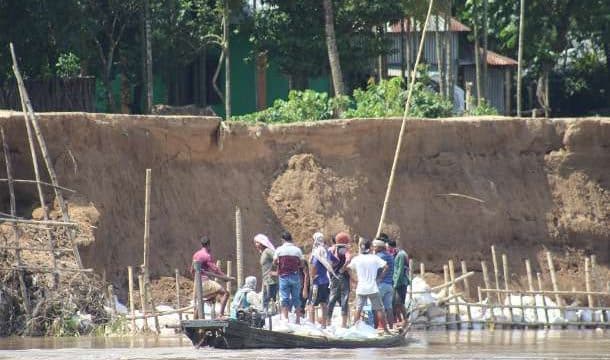
DHAKA (UCAN): The historic St. Joseph’s Church and five adjacent villages at Ranikhong in Netrokona district, northeast Bangladesh, face grave risks due to the erosion and unplanned sand extraction of the Someshwari river which flows from the neighbouring Indian state of Meghalaya to Bangladesh, Church officials say.
The church, set up in 1912, is the oldest in the Diocese of Mymensingh which comprises about 4,221 ethnic Catholics in 18 villages.
Bishop Ponen Paul Kubi, along with Caritas Mymensingh regional director, Aprubo Mrong, appealled to the government to save the area and local communities.
“The situation is bad, and support from the government has been inadequate. Now villagers are trying to protect themselves from erosion by collecting money and using voluntary labour,” Father Plinson Mankin, the parish priest, explained.
The priest noted that he has never seen such devastating erosion of the river in his seven years in the parish.
“A major cause is the unplanned sand extraction from the river,” Father Mankin said adding that locals organised human chains and rallies opposing it.
Mrong, said that that Caritas Mymensingh provided 3,000 taka ($271) in cash to 200 affected families to help them “protect the area using trees, bamboo, and sandbags.”
He also blamed unplanned and illegal sand extraction from the river for the disaster.
The sand extraction “has continued while massive erosion is going on. If sand extraction is not stopped, you cannot halt river erosion,” Mrong said
“Use of dredgers to extract sand from 21 to 36.5 metres deep inside the river, often from the close proximity of riverbanks, severely damages the compact situation of the river. The natural system is lost, and riverbanks continue to collapse,” he said.
The sand extraction “has continued while massive erosion is going on. If sand extraction is not stopped, you cannot halt river erosion,” Mrong said.
“The Church-run school and Church graveyard are under threat now, and the Church faces risks as well if the sand extraction continues to trigger river erosion,” he added.
However, Farjana Khanom, chief government officer in the Durgapur sub-district of Netrokona, said the government had taken immediate steps to tackle erosion.
She said the government has already placed hundreds of sandbags on the river banks for slowing down the erosion.
Khanom said her office also submitted a project worth $10 million for river protection and rehabilitation to higher authorities. “We hope it would be approved soon. We are planning to start the project works on October 23,” Khanom said. For victims of erosion, rice as food aid and some tarpaulin tents have been provided.
Khanom also admitted that sand extraction is one of the causes of erosion but also cited another reason.
“It is true sand excavation with dredgers is a cause of erosion and we are examining it. Another cause is that small islets have emerged from the river and bypassed water is causing riverbank erosion. It has become extreme due to the heavy onrush of water from the hills,” she added.










